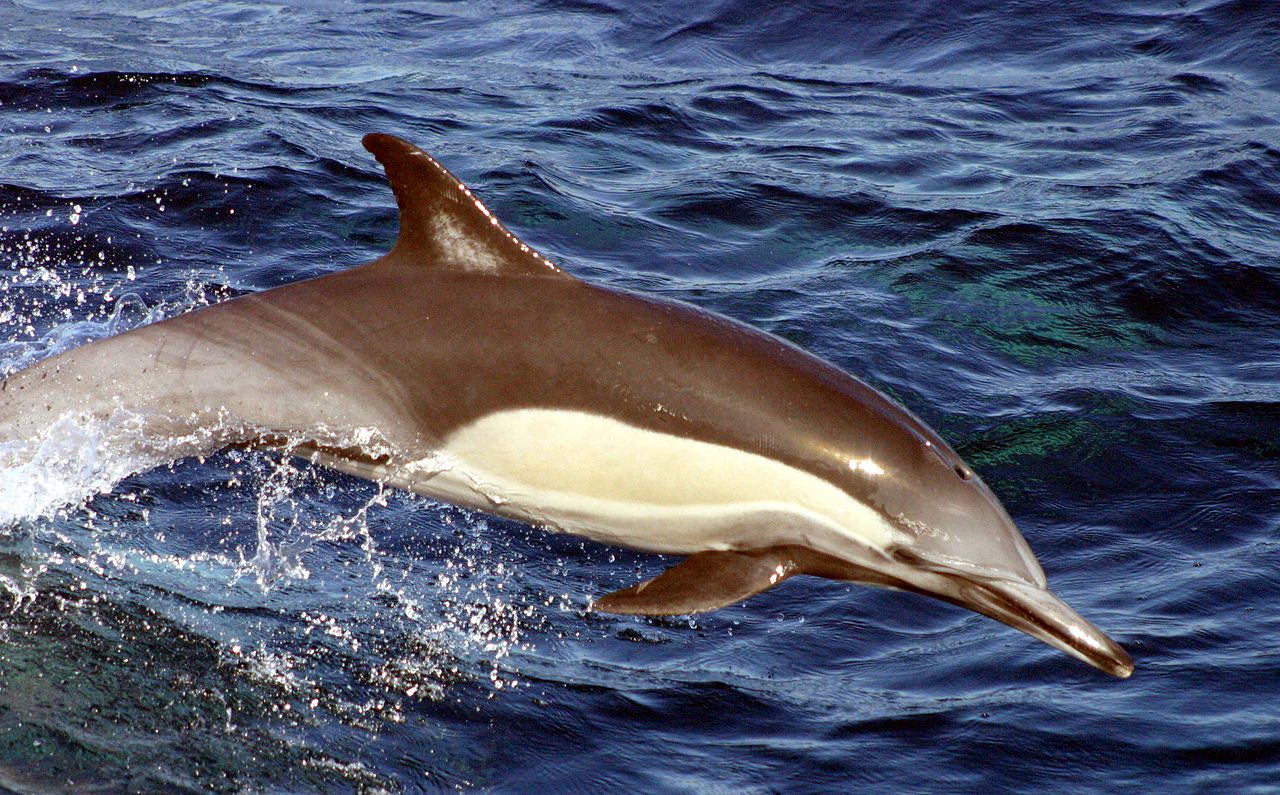
Physical characteristics
The long-beaked common dolphin is medium-sized, but smaller than the more popular bottlenose dolphin. Adults range between 1.9 and 2.5 m (6.2 and 8.2 ft), long, and can weigh between 80 and 235 kg (176 and 518 lb), although a range between 80 and 150 kg (180 and 330 lb) is more common.[5] Males are generally longer and heavier.[5] The color pattern on the body is unusual. The back is dark and the belly is white, while on each side is an hourglass pattern colored light grey, yellow or gold in front and dirty grey in back.[6] This species also has a rounded melon on tops of their heads used for echolocation.[4] It has a long, thin rostrum with up to 60 small, sharp, interlocking teeth on each side of each jaw.[7] They have more teeth than any other delphinids.[8]Taxonomy
Delphinus tropicalis in the Red Sea
The Indo-Pacific common dolphin is sometimes considered a separate species (D. tropicalis), but is more often considered a form of the long-beaked common dolphin.[1][3]
Behavior
Delphinus capensis with whale watching vessels off Kochi, Japan
Diet
The long-beaked common dolphin has a varied diet consisting of small schooling fish, such as sardines, anchovies, mackerels, pilchards, mullet, drum or croaker. These dolphins may occasionally eat small cephalopods such as octopuses and squid, and more rarely eat small crustaceans like large shrimp or small crab. Since they gather in huge superpods and there is seldom enough food in one place to support all of them, smaller groups leave the main pod for a few hours to feed.[11] They are able to dive in the water to about 900 ft (280 m) and hold their breath for up to 8 min to catch prey.[4]Reproduction
The long-beaked common dolphin has a gestation period of 10 to 11 months typically during spring or autumn.[4][5] The newborn calf has a length of between 80 and 100 cm (2.6 and 3.3 ft) and a weight of about 10 kilograms (22 lb).[5] The young and juvenile dolphins coloration and patterns are darker than the adults.[11] Typical interbirth interval ranges from one to three years.[5] In captivity, this dolphin has hybridized with the common bottlenose dolphin (Tursiops truncatus).[3][12] One of the hybrids has been bred back to a bottlenose dolphin, demonstrating such hybrids are fertile.[12] The long-beaked common dolphin can live up to 40 years.[4]Relationship to humans and other species
Long-beaked common dolphins are not common in human care as they are extremely difficult to keep in captivity. In the wild, however, they have been seen travelling with bottle-nosed dolphins, pilot whales, and yellowfin tuna.[13]Conservation
Delphinus capensis is covered by the Memorandum of Understanding Concerning the Conservation of the Manatee and Small Cetaceans of Western Africa and Macaronesia[14] and the Memorandum of Understanding for the Conservation of Cetaceans and Their Habitats in the Pacific Islands Region (Pacific Cetaceans MoU).[15] One of the main threats to the Long-Beaked Common Dolphin is fisheries. Out of 930 dolphins observed off of Peru between 1985 and 2000, 120 of them had many lacerations on their head, skin, appendages, and teeth. Most of these injuries were from fisheries-related connection.[16] Another threat to this species is pollution because many of them have shown signs of organochlorine residue on their blubber.[17] On the coast of California there are only about 25,000 to 43,000 dolphins and on the coast of South Africa there are 15,000 to 20,000.[18]Long-beaked common dolphin range


No comments:
Post a Comment
Note: Only a member of this blog may post a comment.